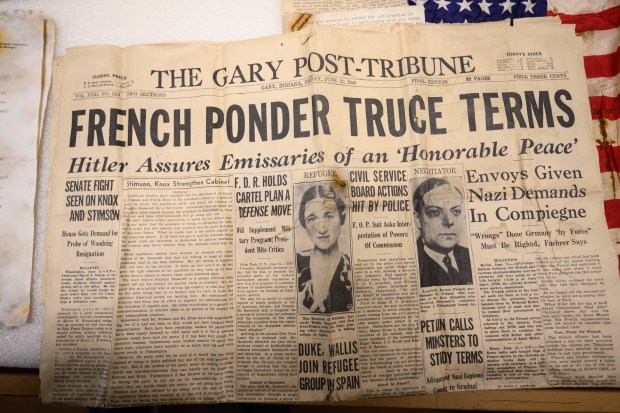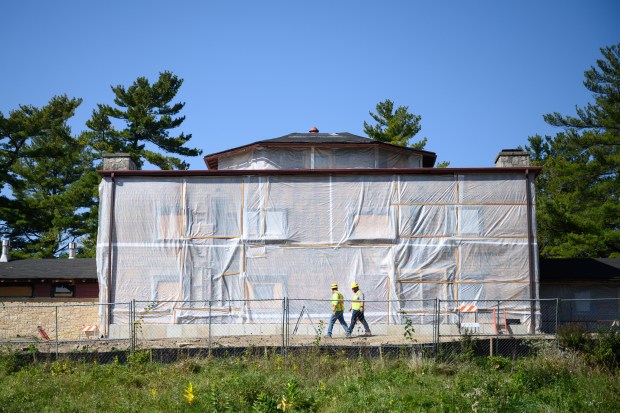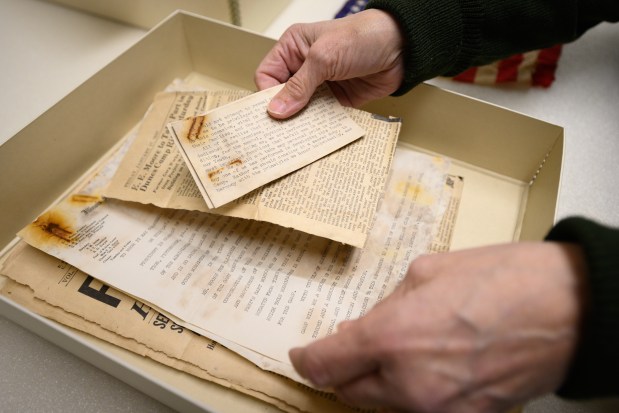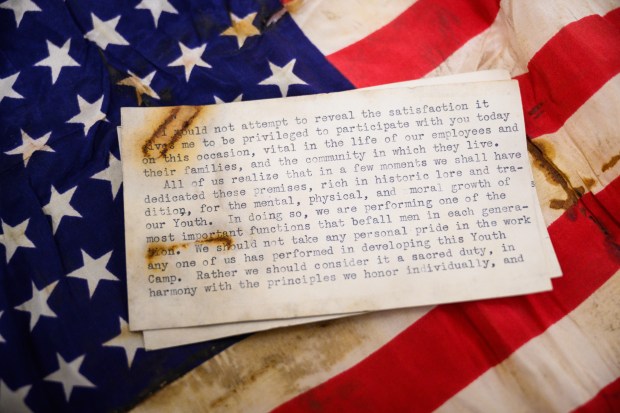As construction continues for shoring up the Good Fellow Lodge, a time capsule emerged from hiding recently.
“When the contractor hit it, we got a phone call, and it was like, ‘Oh my gosh, it’s incredible!’” said Judy Collins, historical architect at Indiana Dunes National Park. The time capsule was in the northwest corner of a main block of the lodge, the three-story portion of the building.
The battered copper box, encased in concrete, held a variety of documents that tell of the Good Fellow Camp’s origins, along with a 48-star flag. Alaska and Hawaii didn’t achieve statehood until 1959.
“When it all came out, it was very damp,” Collins said. She carefully peeled it all apart so the moist, moldy artifacts could dry out.
Two note cards contain a speech by U.S. Steel Vice President Earl Moore at the camp’s dedication on Jan. 18, 1941.
“All of us realize that in a few moments we shall have dedicated these premises, rich in historical lore and tradition, for the mental, physical and moral growth of our youth,” his speech said. “In doing so, we are performing one of the most important functions that befall men in each generation.”
A Post-Tribune front page from June 21, 1940, announces the construction of the new camp but puts it in perspective.
Collins pointed to headlines dominating the top of the front page. “It just puts it all in context of that time period,” she said.
“Hitler Assures Envoys of an ‘Honorable Peace’” one headline reads. “Duke, Wallis Join Refugee Group in Spain,” another says. World War II had broken out in Europe, although the United States didn’t enter the war until about 18 months later.

The Good Fellow Camp plans called for a massive complex that included the pump house, swimming pool, baseball diamond, basketball and tennis courts and more. “Actually, there was supposed to be a couple of cabin areas, and they were able to finish only one,” Collins said.
“No one had ever developed a steel swimming pool, so it was actually breaking ground there,” she said.
The Good Fellow Camp is just one of two such examples in the National Park Service of “welfare capitalism” programs to keep employees happy and not striking, Collins said. The other is at New River Gorge National Park in West Virginia.
Employers offered food pantries, education, medical clinics, tutoring, English language instruction for immigrants and more to deter labor unrest, Collins said.
The Good Fellow Lodge operated until the mid-1970s. “There was a massive downturn in the steel industry,” and the camp was one of the costs cut, she said. At the same time, there was legislation in Congress for a major expansion of the national park. The Good Fellow Camp was right on the park’s boundary, and U.S. Steel approached the National Park Service to sell the property.

The large lodge was mothballed.
“When you mothball, you keep a roof on it. You keep windows secure. You keep vents secure,” Collins explained. You also maintain ventilation in the building. At the Good Fellow Lodge, dehumidifiers were running in the basement.
Even so, the lodge suffered from lack of use. Raccoons moved in by the dozens.
In the mid-1990s, the park began looking at restoration operations for the lodge. After originally being considered for use as an environmental education center, another structure, used by the Dunes Learning Center, was erected for classroom space, with the learning center launched in 1998.
In 2005, the park service did a report on historic structures, which included the Good Fellow Lodge. Help was on the way, although it took a long time to come.

Funding from the Great American Outdoors Act is paying for restoration work at the lodge as well as Bailly Homestead and the House of Tomorrow, the last of the 1933 Chicago World’s Fair homes in Beverly Shores to be renovated.
Collins and facilities chief Todd Ravesloot toured the lodge to see how the construction was going, she said. They looked up and saw how rotted some of the beams were. “The floor decking was holding everything together,” she said.
Construction work is expected to be done late next year. The Good Fellow Lodge will be used for Indiana Dunes National Park staff training and meetings when renovations are complete.
“Now we’re trying to figure out what we’re going to place in the new time capsule,” she said.
This time, it won’t be forgotten. Collins keeps a document – now at 15 pages – of major milestones in the park’s history. The time capsule will be included.
Doug Ross is a freelance reporter for the Post-Tribune.




